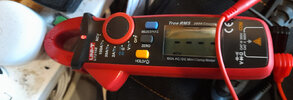- Joined
- 31 May 2023
- Messages
- 2
- Reaction score
- 0
- Country



I appreciate your concern. Better probing it with the tester than poking it with my fingers though, I think.Put the tester away you are not qualified to use it!

 shown here showing my power supply is live, with the non contact voltage test, and these can also test for current with non contact, but also has the option to plug in leads to test as well, and my cheap version was £35 so a tad more expensive to a neon screwdriver, even if less likely to give false readings.
shown here showing my power supply is live, with the non contact voltage test, and these can also test for current with non contact, but also has the option to plug in leads to test as well, and my cheap version was £35 so a tad more expensive to a neon screwdriver, even if less likely to give false readings.Neon and electronic screwdrivers are fantastic devices and I wouldn't want to lose the wonderful facilities the pair of them offer.Light-up screwdriver electrical detectors, also known as neon test screwdrivers, work based on a simple principle: they have a neon lamp inside connected to a resistor, and when you touch the metal tip of the screwdriver to a live wire and your finger to the cap on the other end, a tiny current flows through this circuit, causing the neon lamp to glow. This indicates the presence of voltage. However, they can be misleading because they only confirm the presence of voltage, but not its amount or if there's enough current to operate a device. Also, false positives can occur due to induced voltage from nearby live wires. Plus, if your body is well insulated from the ground (for instance, you're wearing rubber-soled shoes), the lamp might not light up even when the wire is live, leading to potentially dangerous assumptions.
Overall I think they are a dangerous tool.
If you need to find a tradesperson to get your job done, please try our local search below, or if you are doing it yourself you can find suppliers local to you.
Select the supplier or trade you require, enter your location to begin your search.
Are you a trade or supplier? You can create your listing free at DIYnot Local
